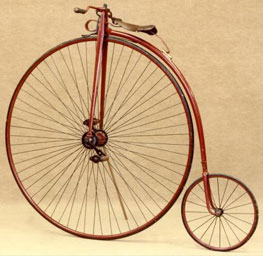Bicycles & Motorcycles
The first bicycle

No single time or person can be identified with the invention of the bicycle. The modern day bicycles, descended from an early type of push-bike, without pedals, propelled by the rider's feet pushing against the ground, which were known as Velocipedes. These appeared around 1800, used iron-banded wagon wheels, and were called "bone-crushers," both for their jarring ride, and for their tendency to toss their riders.
This eventually led to the development of high-wheeled bicycles. An example of a high-wheeled bicycle was the Penny Farthing, also referred to as the 'High' or 'Ordinary' bicycle, and the first one was invented in 1871 by British engineer, James Starley. The Penny Farthing was the first really efficient bicycle, consisting of a small rear wheel and large front wheel pivoting on a simple tubular frame with tires made of rubber. Many of the old bikes had very large front wheels, because it was believed that the bigger the front wheel, the faster the bike rode.
The next development came about in England in the United Kingdom in the early 1880's, when the 'safety bicycle' was invented. This particular bike, which would become the model for the modern bicycle, had a chain, sprocket driving rear wheel and equal sized wheels.
The first motorcycle

Motorcycles descended from bicycles. Daimler's wooden-framed 'bone crusher' Gottlieb Daimler (who later teamed up with Karl Benz to form the Daimler-Benz Corporation) is credited with building the first motorcycle in 1885. It had one wheel in the front and one in the back, although it had a smaller spring-loaded outrigger wheel on each side. It was constructed mostly of wood, with the wheels being of the iron-banded wooden-spoked wagon-type. It was powered by a single-cylinder Otto-cycle engine.
If one counts two wheels with steam propulsion as being a motorcycle, then the first one may have been American. One such machine was demonstrated at fairs and circuses in the Eastern US in 1867, built by one Sylvester Howard Roper of Roxbury, Massachusetts. There is an existing example of a Roper machine, dated 1869. It is powered by a charcoal-fired two-cylinder engine, whose connecting rods directly drove a crank on the rear wheel. This machine predates the invention of the safety bicycle by many years, so its chassis is also based on the 'bone-crusher' bike.
Motorcycles have come along way from when they were first created by doing nothing more than adding an engine to a bicycle. Now motorcycles are some of the most technical machines out there.